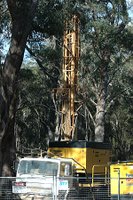(DJW EDIT: Identification subsequently confirmed on 7 March 2012 as Prasophyllum appendiculatum). At the time I originally published this blog, it was believed that this plant was so rare that the National Parks and Wildlife Service had listed it on the Endangered Species List, and that it was protected by legislation.
 |
| Prasophyllum appendiculatum (Amended ID, by Dr Mark Clements) |
This plant is listed as an Endangered Species under the NSW Threatened Species Conservation Act 1995. 83 individual plants might sound like a lot, but it is the restricted location of these plants which is the issue. After all, a bulldozer could wipe out the lot of them in a couple of hours.
In view of the amended ID for these plants - the reference to them being an Endangered Species is no longer supported.
DJW 7 March 2012 |
| Prasophyllum appendiculatum (Amended ID, by Dr Mark Clements) |
W.L.O.
Close-up
Recent amendments, "under the Threatened Species Legislation Amendment Act 2004, passed by Parliament in November 2004, signal the NSW Government’s commitment to further integrating conservation with mainstream decision-making about how we use land and build our economy. .... The Amendment Act puts greater emphasis on land-use planning which focuses on the protection and restoration of native vegetation and threatened species habitat at the landscape scale and integrates with the Government’s other reforms to natural resource management and planning." Source: Dept. of Environment and Conservation webpage on Threatened Species Legislation.
Ok, it is now time to see how this rhetoric gets put into action.
Ultimately, the responsible person is the Minister for Environment and Conservation in NSW, Mr Bob Debus. The Local Member, Mr Matt Brown, Member for Kiama ought be taking notice of this issue.
*****
 The drilling teams from the SCA are closing in on these Orchids.
The drilling teams from the SCA are closing in on these Orchids.
Already the Department of Natural Resources, as contractors for the SCA, are drilling a second "production bore" along Tourist Road, near the Nepean River, about 2 Km to the east of these Orchids. Another bore, or maybe two, are proposed for the very area where these Orchids are located.
They are building bores at the rate of one every 4 or 5 days, so these Orchids may have less than a week to live - unless the SCA is told to stop this boring - NOW, today.
 The drilling teams from the SCA are closing in on these Orchids.
The drilling teams from the SCA are closing in on these Orchids.Already the Department of Natural Resources, as contractors for the SCA, are drilling a second "production bore" along Tourist Road, near the Nepean River, about 2 Km to the east of these Orchids. Another bore, or maybe two, are proposed for the very area where these Orchids are located.
They are building bores at the rate of one every 4 or 5 days, so these Orchids may have less than a week to live - unless the SCA is told to stop this boring - NOW, today.

3 comments:
Hi Denis,
Just a correction : this orchid has been identified by orchid experts from the Australian National Botanic Gardens as either Prasophyllum appendiculatum (Nichols) or an undescribed/unnamed Prasophyllum taxon with affinities to that species. So it is not the Wingecarribee Leek Orchid, nor is either of those identified taxa listed as a threatened species under NSW or Commonwealth legislation. I have emailed you the relevant correspondence.
best regards and hope you are well,
Nick Corkish
Thanks Nick
Yes, that Post is very old (2006), and has not been retrospectively updated.
Thanks
Denis
All references in this Blog to this species as Wingecarribee Leek Orchid, and to it being an Endangered Species, have been amended.
This is in view of the receipt on 7 March 2012 of advice from Nick Corkish, of the NSW Office of Environment that Dr Mark Clements of CSIRO has identified the plant as Prasophyllum appendiculatum.
Denis Wilson
Post a Comment